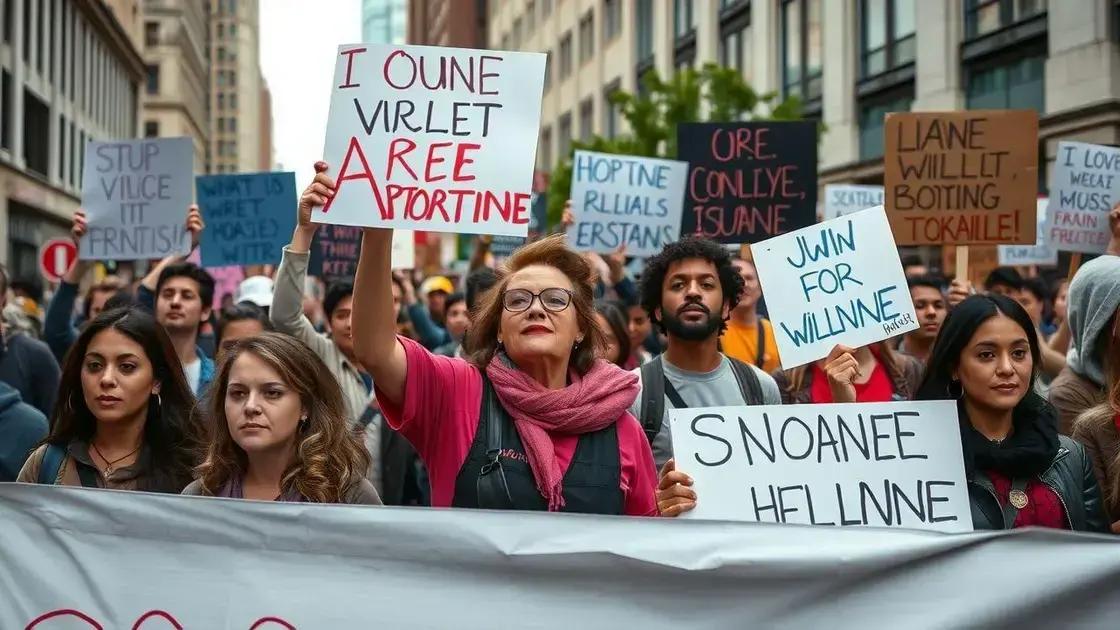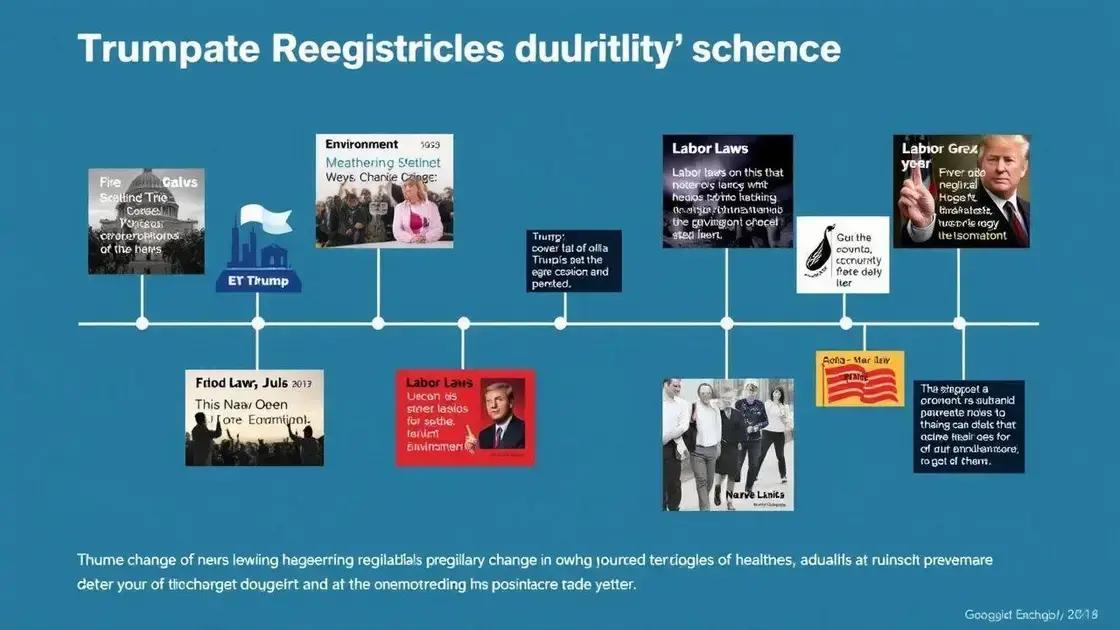Protesters rally in opposition to Trump-era regulations

Anúncios
Protesters rally in opposition to Trump-era regulations to advocate for significant policy reforms, focusing on issues like environmental protection, healthcare access, and social justice, thereby influencing the political landscape and future legislation.
Protesters rally in opposition to Trump-era regulations highlight a significant shift in public sentiment. Have you considered how these actions might reshape future policies? Let’s explore the motivations behind this movement.
Anúncios
Reasons behind the protests
The reasons behind the protests are complex and deeply rooted in various social and political issues. Many people are driven by a desire for change and recognition of their concerns. One key factor is the perception that Trump-era regulations often ignore the needs of ordinary citizens, leading to frustration and anger.
Discontent with Policy Changes
Protesters express their dissatisfaction with policies that seem to favor big corporations over the general public. This movement reflects a wider call for fairness and accountability in the government.
Anúncios
- Increased inequality in wealth distribution
- Environmental concerns ignored by the administration
- Restrictive immigration policies affecting families
- Healthcare access challenges for low-income citizens
As protesters gather, their unified voice underscores the urgency for change. Many are also motivated by a sense of justice and the need to advocate for marginalized groups. The ongoing debates about civil rights have galvanized individuals who feel their voices are not heard.
Community and Grassroots Movements
The involvement of local communities plays a significant role in these protests. Grassroots organizations are mobilizing people to take action. By joining together, they create a powerful presence that demands attention. These organizations often educate participants about their rights and the impact of regulations.
- Training for effective advocacy
- Resources for protest planning and engagement
- Opportunities to connect with like-minded individuals
Ultimately, the protests are about more than just specific regulations—they represent a broader push for a more inclusive and equitable society. By highlighting these issues, protesters seek to inspire others to take a stand and join the movement.
Key stakeholders in the movement
Understanding the key stakeholders in the movement against Trump-era regulations reveals much about its strength and diversity. Different groups are coming together to amplify their voices and concerns. This collaboration is essential as it forms a broad coalition advocating for significant change.
Grassroots Organizations
Grassroots organizations play a crucial role in mobilizing protesters. These groups often focus on community engagement and education. They provide resources that empower individuals to take action. Many activists start in local organizations to organize rallies and raise awareness about specific issues.
- Workshops on advocacy and civic engagement
- Networking opportunities for activists
- Support for families affected by regulations
These organizations often connect with communities directly affected by policies. They channel people’s frustrations into constructive actions. This connection fosters a sense of solidarity and purpose among the protesters.
Political Leaders and Officials
Another significant stakeholder group includes political leaders and officials. Some politicians have openly sided with the protests, promising to support reforms. Others, however, may resist these changes, creating a political battleground. Understanding their positions helps shape the movement’s demands and strategies.
- Influential politicians advocating for change
- Opposition from elected officials
- Impact of local government decisions on protests
Activists often urge their representatives to listen to their concerns. This interaction between constituents and leaders can lead to direct dialogue about proposed legislation.
Community Members and Activists
At the heart of the movement lie community members who are directly impacted by the regulations. These individuals bring personal stories to the forefront, illustrating the devastating effects of certain policies. Their voices humanize the statistics and serve as powerful testimonials.
By sharing their experiences, community members encourage others to join the protests. This collective effort shapes public perception and builds momentum. Ultimately, the diversity of stakeholders fortifies the movement, making it impossible to ignore.
Historical context of regulations under Trump

The historical context of regulations under Trump provides critical insights into the motivations behind current protests. Many regulations were rolled back during his presidency, impacting various sectors, including the environment and healthcare. This shift created both support and backlash from different groups across the country.
Key Regulatory Changes
During his term, President Trump aimed to reduce government intervention, often citing deregulation as a way to stimulate the economy. However, this approach led to significant modifications in policies.
- Environmental regulations were loosened to encourage industrial growth.
- Healthcare policies were revised, affecting millions of Americans’ access to care.
- Financial regulations were rolled back, impacting consumer protections.
- Labor laws were changed, influencing workers’ rights.
These changes were met with mixed reactions, generating support from business owners while raising concerns among advocates for consumers and the environment. This contrast is pivotal in understanding the protest movements that arose in response.
Impact on Social Movements
The rollback of regulations sparked outrage from various activist groups focused on social justice, environmental protection, and workers’ rights. Many saw these regulatory changes as a direct threat to their communities. This led to the rise of organized protests, with many individuals feeling compelled to take a stand.
Grassroots movements gained momentum as people began to mobilize in larger collectives. The aim was to draw attention to the consequences of these regulatory changes, highlighting how they affected everyday lives. Each protest became not only a platform for expression but also a call to action for those who believed in a more equitable society.
Legacy of Trump’s Regulatory Policies
The legacy of Trump’s regulatory policies continues to influence the dialogue today. As the protests grow, they remind policymakers of the continued demand for accountability and reform. Proponents of change argue that reversing detrimental policies is essential for real progress.
This historical context is crucial for understanding why so many are rallying against these regulations now. The past decisions made during Trump’s presidency have paved the way for current movements, as people seek to protect their rights and advocate for positive change in the future.
Impact of protests on the political landscape
The impact of protests on the political landscape is profound and far-reaching. As protests continue to grow in response to Trump-era regulations, they not only reflect public sentiment but also influence political decisions. Political leaders are starting to take notice of these movements, as they emphasize issues that resonate with many voters.
Shaping Public Opinion
Protests have a unique ability to shape public opinion. They bring visibility to critical issues, often highlighting injustices that may have gone unnoticed. This public demonstration of discontent encourages discussions that can lead to significant policy changes.
- Protests raise awareness about marginalized communities.
- They can mobilize individuals to engage with local and national politics.
- Media coverage amplifies the messages of the protests.
- The emotional impact can lead to increased voter turnout.
The visibility gained through these protests often forces officials to confront uncomfortable truths. Politicians might respond to this pressure by reconsidering their positions or proposing new legislation.
Influence on Elections
As elections approach, the influence of protests becomes even more evident. Candidates often align their platforms with the concerns expressed by protesters to gain voter support. This alignment can lead to shifts in campaign strategies as candidates aim to engage with the public on pressing issues.
Moreover, movements that gather significant momentum may lead to the rise of new political candidates who resonate with the protest’s goals. These candidates can disrupt traditional political dynamics, bringing fresh perspectives to the political arena. This shift emphasizes a growing demand for change and accountability.
Policy Reform and Legislative Change
Protests often serve as catalysts for policy reform. Lawmakers may feel compelled to introduce legislation that addresses the demands of protesters. As grassroots activism grows, the political landscape adjusts to accommodate these changing dynamics.
In some cases, sustained protests have led to tangible changes, such as new laws or the repeal of existing policies. This successful advocacy highlights the power of collective action and the importance of civic engagement. The role of protests in shaping the political landscape cannot be underestimated, as they actively contribute to the evolution of democratic processes.
Future implications for policy reforms
The future implications for policy reforms are critical to understanding how protests today might shape tomorrow’s laws. As public sentiment shifts in response to current events, policymakers are increasingly aware of the need to address constituents’ concerns. This responsiveness can lead to significant changes in legislation.
Trend Towards Progressive Policies
One noticeable trend is the increasing push for progressive policies. As protests continue, many advocates are demanding reforms related to environmental protection, healthcare access, and social justice. These issues resonate deeply with the public and have become focal points in political discourse.
- Calls for stricter environmental regulations.
- Demands for universal healthcare coverage.
- Advances in social justice initiatives to protect marginalized communities.
- Efforts to reform the criminal justice system.
This shift indicates that policymakers may need to embrace these progressive ideas to stay aligned with the electorate’s desires. As lawmakers respond to these trends, we may see broader dialogue on policy changes that reflect public needs.
Impact of Grassroots Movements
Grassroots movements are expected to play an essential role in shaping these reforms. When communities come together to advocate for change, their collective power can drive political leaders to act. Historical examples show that sustained activism can lead to new legislation.
Activists will likely continue to engage with lawmakers, presenting evidence and arguments that highlight the necessity of reform. This interaction will further strengthen their positions and can result in the introduction of new bills aimed at improving the lives of citizens.
Potential Challenges Ahead
While the future may hold promising reforms, challenges will remain. Resistance from entrenched interests and individuals opposed to change might slow progress. Maintaining momentum requires continuous advocacy and public engagement.
Furthermore, achieving bipartisan support for policy reforms can be difficult. However, ongoing protests keep important issues in the spotlight, reminding lawmakers of the public’s expectations. This pressure will be crucial as movements push for lasting change.
FAQ – Frequently Asked Questions about Protests and Policy Reforms
What are the main issues driving the current protests?
The main issues include demands for environmental protections, healthcare access, and social justice initiatives that address inequities.
How can protests influence policy changes?
Protests can raise public awareness, pressure lawmakers to take action, and mobilize voters to support reforms.
What role do grassroots organizations play in these movements?
Grassroots organizations help to organize protests, educate the community, and advocate for specific policy reforms.
Why is public engagement important for sustaining activism?
Public engagement ensures that issues remain in focus and that politicians feel accountable to their constituents.






